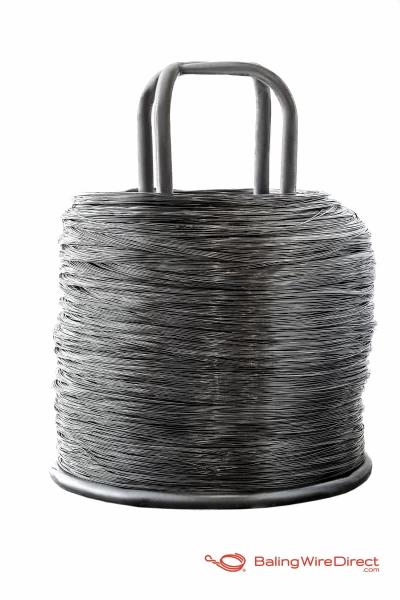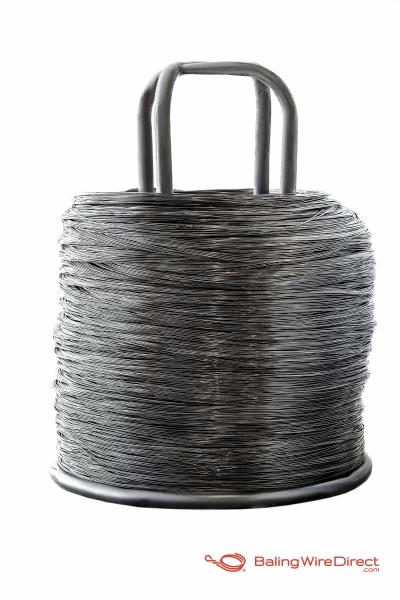Black Annealed Baling Wire By The Stem
Our American-made black annealed wire is ductile and uniform, perfect for recycling and waste management auto-tie balers.
Product specifications
Our black annealed wire works in auto-tie horizontal balers and is made to the highest quality standards
| Wire gauge | 9 - 12 gauge wire |
| Load strength | 932–1118 lbs |
| Tensile strength | 65,000–78,000 psi (448.21–537.79 MPa) |
| Quality control | Extensive testing on every carrier |
| Wire diameter | .102–.148 inches |
| Carbon grade | 1018 |
| Stem size | ? |
| Feet per stem | 800’ |
| Finish | Thermal annealed with wax coating |
Baling Wire Direct Reviews
Black annealed wire use cases
Ductile, high-performance wire for a wide range of applications, including the following:
Our manufacturing process
From raw materials through the annealing process to quality testing, every stage of our baling wire manufacturing process is done to the highest quality standards.
It all starts with a select family of melting plants where we purchase 100% American-made steel billets. Each is delivered with metallurgical traceability specs certifying chemical composition to meet the end product’s load and tensile strength.
From there our 125-person production staff and five onsite engineers get to work.
First, the newly-formed carbon steel wire is descaled through mechanical reverse-bending. This gives a completely scale-free surface. Even better, mechanical descaling means we eliminate harsh, environmentally unsafe chemicals from the production process.
Next, the wire is drawn through a heavy-duty, bull-block continuous wire machine, and low-carbon (1018) grades are air-cooled to ensure consistent tensile strength. Then, it’s on to the annealing process.
Our annealing process
Annealing uses heat to make steel wire more workable. It involves heating the steel above its recrystallization temperature, maintaining that temperature, and then cooling it.
The three carbon annealing cycles are known as recovery, recrystallization, and grain growth.
- Recovery: softens the wire through the removal of primarily linear defects called dislocations. Each strand, measuring exactly 0.135 inches, is heated with natural gas in a fluidized sand furnace.
- Recrystallization: deformed grains are replaced by a new set of defect-free grains that nucleate and grow until the original grains have been entirely consumed. This process occurs when the wire is heated above its recrystallization temperature (we heat our baling wire to 850 degrees Celcius).
- Grain growth: the microstructure continues to coarsen to reduce the material s total energy.
Our annealing process results in a uniform atomic structure increases ductility, and reduces brittleness. The result: wire that is easy to use and durable.
After the wire is annealed, we apply a coat of wax to the finished product. This creates a beautiful surface finish and also protects the wire. The surface finish ensures that the wire never leaves a mess and always feeds smoothly in automatic baling machines.
Our quality control process
Our process begins with tensile testing samples from every carrier, pushing them to their breaking point. Any carriers with failed wires are immediately removed, ensuring only the strongest and most reliable carrier wire gets shipped.
But our commitment to quality doesn t end there. We carefully spool the wire through a coiling machine and cut it into 50 or 100-lb boxes. These boxes are then palletized, banded, and shrink-wrapped, ensuring they arrive at your doorstep in pristine condition.
To make your experience even more seamless, our Autoship™ system keeps you informed every step of the way. You ll receive tracking information via your preferred contact method (email, text message). The entire process takes just 1-3 business days.
With our set-and-forget reordering and invoicing, you ll get exactly what you need, when you need it, without sacrificing USA quality or customer service.
Baling wire sizes
We sell annealed stem wire in 9 to 12 gauge sizes. Counterintuitively, a wire’s gauge has an inverse correlation to its diameter. That’s because of how the wire is manufactured.
Wire is made by drawing a metal rod through a series of dies, each with a hole slightly smaller than the last. This process, known as drawing, stretches the metal, making it longer and thinner. The gauge number was originally defined as the number of times a wire was drawn to reach a certain size. So, a wire that has been drawn more times (and is therefore thinner) has a larger gauge number.
|
Wire gauge |
Diameter in inches |
|
9 |
0.1481 |
|
10 |
0.1352 |
|
11 |
0.123 |
|
12 |
0.102–0.104 |
Types of wire we offer
We offer our annealed wire, galvanized wire (including high-tensile), and bale ties (in single loop and double loop).



